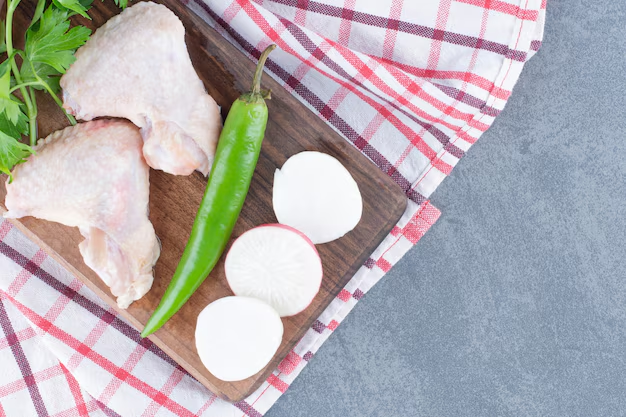How Long Is It Safe to Keep Raw Chicken in the Refrigerator?
We’ve all faced the conundrum of discovering a package of raw chicken in the refrigerator and wondering if it's still fresh enough to cook. Handling raw poultry with care is crucial to ensure food safety and avoid foodborne illnesses. Let’s dive into how long raw chicken can be safely stored in the refrigerator, along with key insights into optimal storage practices.
🕒 Understanding Shelf Life: Raw Chicken in the Refrigerator
The General Rule: Raw chicken, including whole birds and individual pieces, is typically safe to store in the refrigerator for 1-2 days. This timeline aligns with general food safety guidelines and helps ensure the chicken remains fresh, safe, and flavorful.
While it might seem brief, these guidelines are established to prevent the growth of harmful bacteria which thrive when raw poultry is stored too long, even in refrigerated conditions.
Why This Time Frame?
- Bacterial Growth: Refrigerators slow down bacterial growth but do not stop it entirely. Limiting storage time reduces the risk of bacteria like Salmonella and Campylobacter, commonly associated with poultry, multiplying to unsafe levels.
- Quality Assurance: Beyond harboring bacteria, prolonged storage can impact the quality of the chicken, affecting taste and texture.
🏠 Proper Storage Practices for Raw Chicken
Keeping chicken fresh in the fridge isn’t just about time; it's also about how you store it. Here are effective storage techniques:
Original Packaging vs. Repackaging
Original Packaging: If the packaging is intact, it's usually best to leave it as is. The packaging is designed to maintain freshness and reduce contamination risk.
Repackaging Tips: If the original packaging is opened, transfer the chicken to an airtight container or use heavy-duty freezer bags to prevent air exposure.
🚫 Preventing Cross-Contamination
- Separate Storage: Store chicken on the bottom shelf of the refrigerator to prevent juices from dripping onto other foods.
- Use of Containers: Consider placing the packaged chicken on a tray or plate as an additional safety barrier.
Recommended Refrigerator Temperature
- Keep your refrigerator set to 40°F (4°C) or below. This helps in maintaining the freshness and safety of all stored perishable foods.
🐔 The Role of Freezing
If there’s doubt about using your raw chicken within the 1-2 day window, freezing is your best bet. Freezing halts bacterial growth, significantly extending the shelf life:
- Whole Chicken: Can be frozen for up to a year.
- Chicken Pieces: Generally remain safe for up to 9 months.
Freezing Tips
- Prepping for the Freezer: Remove the original packaging and place the chicken in a freezer-safe, airtight container or heavy-duty freezer bag. Label with the date for easy tracking.
- Thawing Suggestions: Thaw chicken safely in the refrigerator, not on the countertop, to keep it at safe temperatures.
👨🍳 How to Tell If Raw Chicken Has Spoiled
Even with cautious handling, it's crucial to recognize the signs of spoilage:
Visible Changes
- Color: Fresh raw chicken should be pale pink. Discoloration to gray or green indicates spoilage.
- Texture: Slimy residue on the surface suggests bacterial growth and spoilage.
Odor
- A strong, sour smell is a clear indicator the chicken is no longer safe to consume.
📝 Handy Summary for Quick Reference
Keep these quick tips and timelines handy to ensure food safety:
Raw Chicken Storage Timeline
- Refrigerator (40°F or below): 1-2 days
- Freezer (0°F):
- Whole chicken: Up to 1 year
- Chicken pieces: Up to 9 months
Quick Storage Tips
- Store on the bottom shelf to avoid contaminating other foods.
- Use airtight containers or heavy-duty freezer bags for repackaging.
- Freeze chicken if not used within the refrigerator storage timeline.
🤔 How Different Factors Affect Chicken Storage
Storage durations aren't set in stone; several factors can impact freshness:
Packaging and Handling
Improper handling and exposure to non-refrigerated conditions during transit can reduce shelf life.
Chicken Type and Cuts
Certain cuts, like organs and ground chicken, may have slightly different storage durations due to differences in density and exposure.
Fridge Consistency
Ensure your refrigerator maintains a consistent temperature. Frequent door openings and faulty seals contribute to fluctuations, impacting food safety.
🌡️ Dealing with Temperature Fluctuations
Keeping track of your fridge’s temperature is vital for all perishables, including chicken:
- Fridge Thermometers: An inexpensive and reliable tool for verifying internal temperatures.
- Minimize Open Door Time: Plan what you need before opening the door to maintain temperatures.
🔄 Implementing a FIFO System in Your Kitchen
A “First In, First Out” (FIFO) strategy can help you keep track of chicken and other perishables:
- Organize by Date: Always place newer purchases behind older ones.
- Label Everything: Clearly mark containers with purchase or storage initiation dates.
✨ Final Thoughts
Storing raw chicken safely in the refrigerator requires attention to time, temperature, and handling. By following these guidelines, you can reduce food waste and ensure safety in your kitchen. With the correct storage practices and an awareness of spoilage signs, handling raw chicken becomes a straightforward and manageable part of meal prep. Empower your culinary confidence with these simple, effective strategies every time you're handling poultry. 🐣
